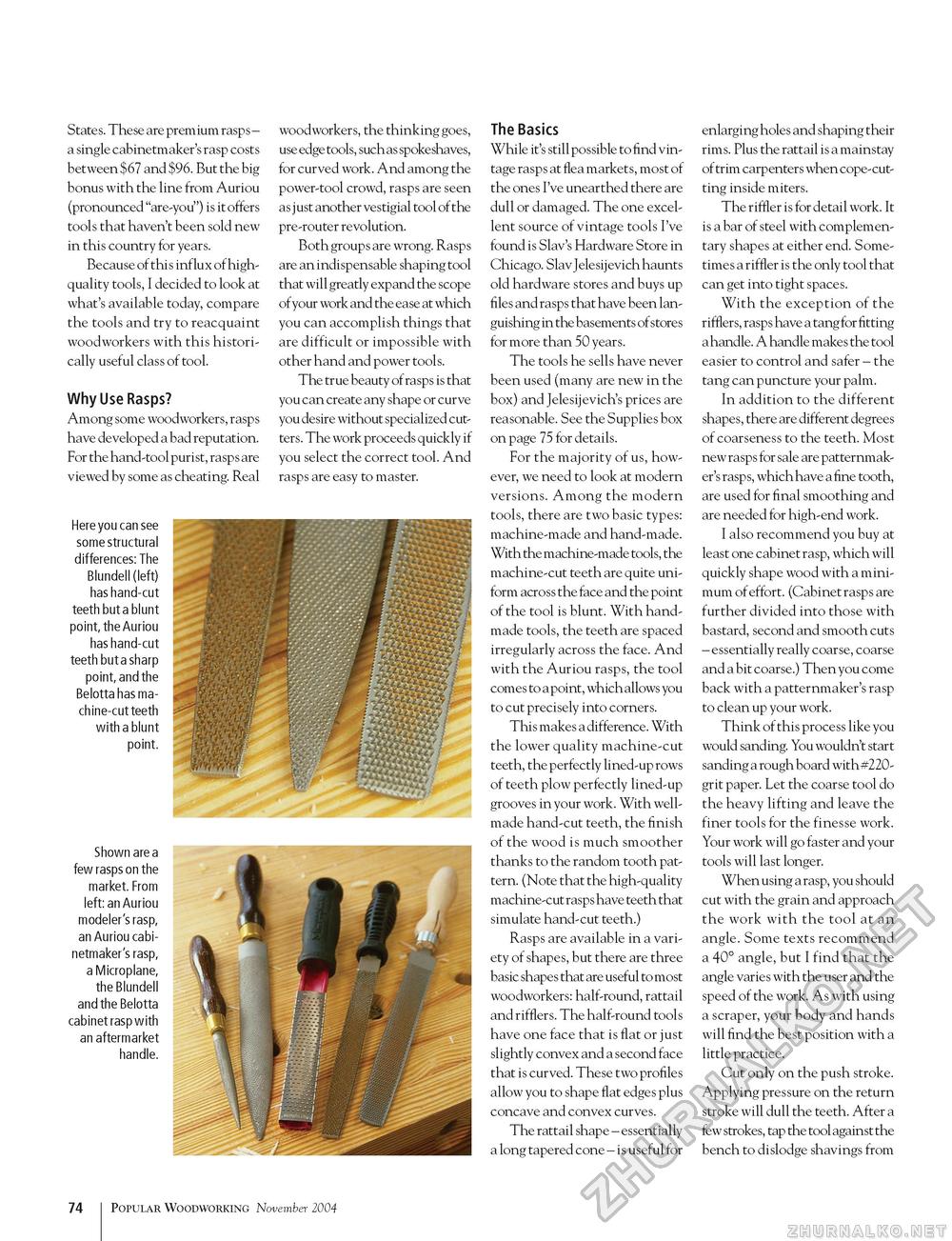Popular Woodworking 2004-11 № 144, страница 75
State s. These are prem ium rasp s -a single cabinetmaker's rasp costs between $67 and $96. But the big bonus with the line from Auriou (pronounced "are-you") is it offers tools that haven't been sold new in this country for years. Because of this influx of high-quality tools, I decided to look at what's available today, compare the tools and try to reacquaint woodworkers with this historically useful class of tool. Why Use Rasps? Among some woodworkers, rasps have developed a bad reputation. For the hand-tool purist, rasps are viewed by some as cheating. Real Here you can see some structural differences: The Blundell (left) has hand-cut teeth but a blunt point, the Auriou has hand-cut teeth but a sharp point, and the Belotta has machine-cut teeth with a blunt point. woodworkers, the thinking goes, use edge tools, such as spokeshaves, for curved work. And among the power-tool crowd, rasps are seen as j ust another vestigial tool of the pre-router revolution. Both groups are wrong. Rasps are an indispensable shaping tool that will greatly expand the scope of your work and the ease at which you can accomplish things that are difficult or impossible with other hand and power tools. The true beauty of rasps is that you can create any shape or curve you desire without specialized cutters. The work proceeds quickly if you select the correct tool. And rasps are easy to master. Shown are a few rasps on the market. From left: an Auriou modeler's rasp, an Auriou cabinetmaker's rasp, a Microplane, the Blundell and the Belotta cabinet rasp with an aftermarket handle. The Basics While it's still possible to find vintage rasps at flea markets, most of the ones I've unearthed there are dull or damaged. The one excellent source of vintage tools I've found is Slav's Hardware Store in Chicago. Slav Jelesijevich haunts old hardware stores and buys up files and rasps that have been languishing in the basements of stores for more than 50 years. The tools he sells have never been used (many are new in the box) and Jelesijevich's prices are reasonable. See the Supplies box on page 75 for details. For the majority of us, however, we need to look at modern versions. Among the modern tools, there are two basic types: machine-made and hand-made. With the machine-made tools, the machine-cut teeth are quite uniform across the face and the point of the tool is blunt. With handmade tools, the teeth are spaced irregularly across the face. And with the Auriou rasps, the tool comes to a point, which allows you to cut precisely into corners. This makes a difference. With the lower quality machine-cut teeth, the perfectly lined-up rows of teeth plow perfectly lined-up grooves in your work. With well-made hand-cut teeth, the finish of the wood is much smoother thanks to the random tooth pattern. (Note that the high-quality machine-cut rasps have teeth that simulate hand-cut teeth.) Rasps are available in a variety of shapes, but there are three basic shapes that are useful to most woodworkers: half-round, rattail and rifflers. The half-round tools have one face that is flat or just slightly convex and a second face that is curved. These two profiles allow you to shape flat edges plus concave and convex curves. The rattail shape - essentially a long tapered cone - is useful for enlarging holes and shaping their rims. Plus the rattail is a mainstay of trim carpenters when cope-cutting inside miters. The riffler is for detail work. It is a bar of steel with complementary shapes at either end. Sometimes a riffler is the only tool that can get into tight spaces. With the exception of the rifflers, rasps have a tang for fitting a handle. A handle makes the tool easier to control and safer - the tang can puncture your palm. In addition to the different shapes, there are different degrees of coarseness to the teeth. Most new rasps for sale are patternmaker's rasps, which have a fine tooth, are used for final smoothing and are needed for high-end work. I also recommend you buy at least one cabinet rasp, which will quickly shape wood with a minimum of effort. (Cabinet rasps are further divided into those with bastard, second and smooth cuts - essentially really coarse, coarse and a bit coarse.) Then you come back with a patternmaker's rasp to clean up your work. Think of this process like you would sanding. You wouldn't start sanding a rough board with #220-grit paper. Let the coarse tool do the heavy lifting and leave the finer tools for the finesse work. Your work will go faster and your tools will last longer. When using a rasp, you should cut with the grain and approach the work with the tool at an angle. Some texts recommend a 40° angle, but I find that the angle varies with the user and the speed of the work. As with using a scraper, your body and hands will find the best position with a little practice. Cut only on the push stroke. Applying pressure on the return stroke will dull the teeth. After a few strokes, tap the tool against the bench to dislodge shavings from 74 Popular Woodworking November 2004 |








